2012 VOLKSWAGEN BEETLE parking brake
[x] Cancel search: parking brakePage 8 of 268

Lower center console
Fig. 7 Overview of the lower center console.
Key to fig. 7:
(1) Lever for:
– Manual transmission
– Automatic transmission
(2) 12 Volt socket
(3) Storage compartment with cup holder in the center console
(4) Center armrest with storage compartment (if equipped)
(5) Parking brake lever
(6) Starter button for the Keyless Access locking and starting system
(7) Storage compartment
Page 118 of 268
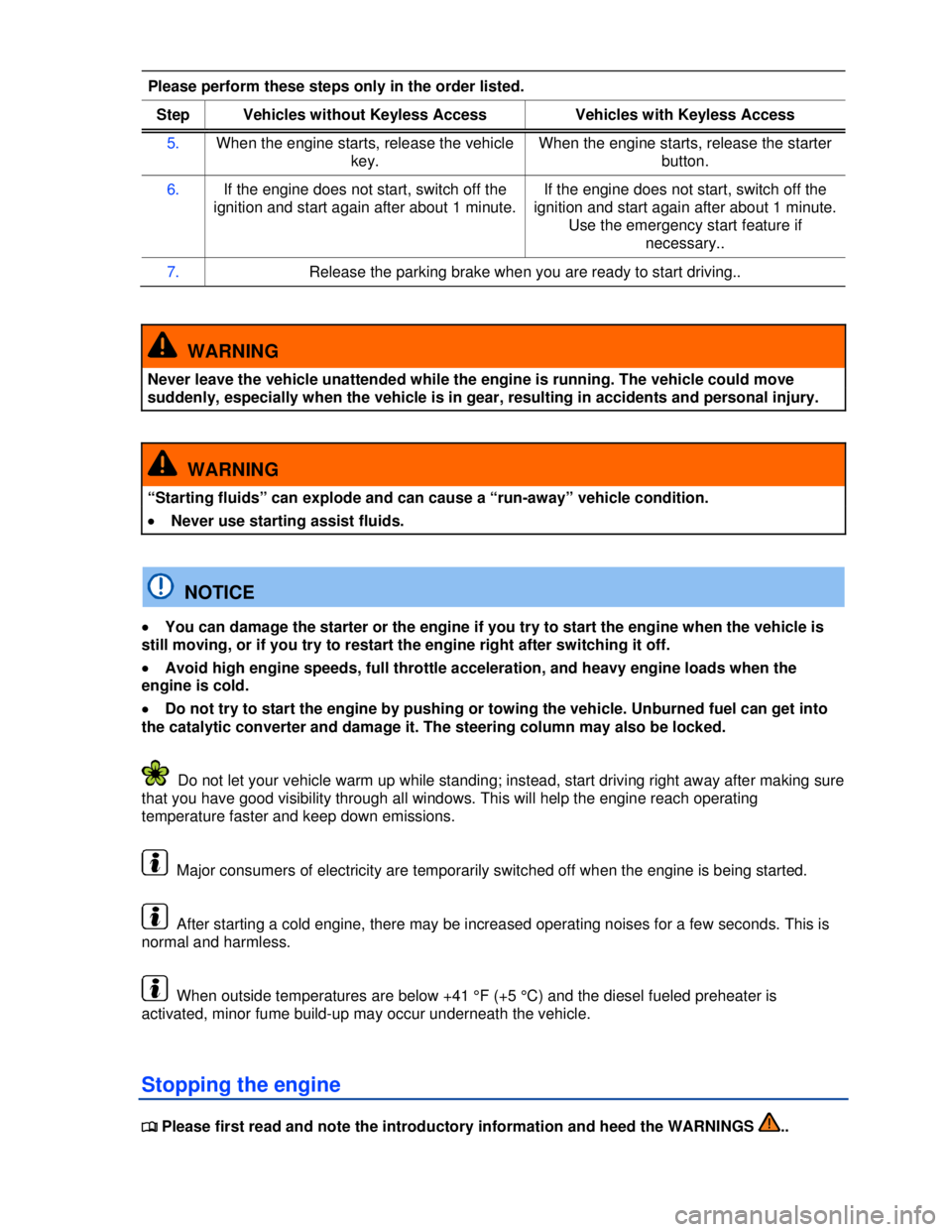
Please perform these steps only in the order listed.
Step Vehicles without Keyless AccessVehicles with Keyless Access
5. When the engine starts, release the vehicle
key.
When the engine starts, release the starter
button.
6. If the engine does not start, switch off the
ignition and start again after about 1 minute.
If the engine does not start, switch off the
ignition and start again after about 1 minute.
Use the emergency start feature if
necessary..
7. Release the parking brake when you are ready to start driving..
WARNING
Never leave the vehicle unattended while the engine is running. The vehicle could move
suddenly, especially when the vehicle is in gear, resulting in accidents and personal injury.
WARNING
“Starting fluids” can explode and can cause a “run-away” vehicle condition.
�x Never use starting assist fluids.
NOTICE
�x You can damage the starter or the engine if you try to start the engine when the vehicle is
still moving, or if you try to restart the engine right after switching it off.
�x Avoid high engine speeds, full throttle acceleration, and heavy engine loads when the
engine is cold.
�x Do not try to start the engine by pushing or towing the vehicle. Unburned fuel can get into
the catalytic converter and damage it. The steering column may also be locked.
Do not let your vehicle warm up while standing; instead, start driving right away after making sure
that you have good visibility through all windows. This will help the engine reach operating
temperature faster and keep down emissions.
Major consumers of electricity are temporarily switched off when the engine is being started.
After starting a cold engine, there may be increased operating noises for a few seconds. This is
normal and harmless.
When outside temperatures are below +41 °F (+5 °C) and the diesel fueled preheater is
activated, minor fume build-up may occur underneath the vehicle.
Stopping the engine
�
Page 119 of 268
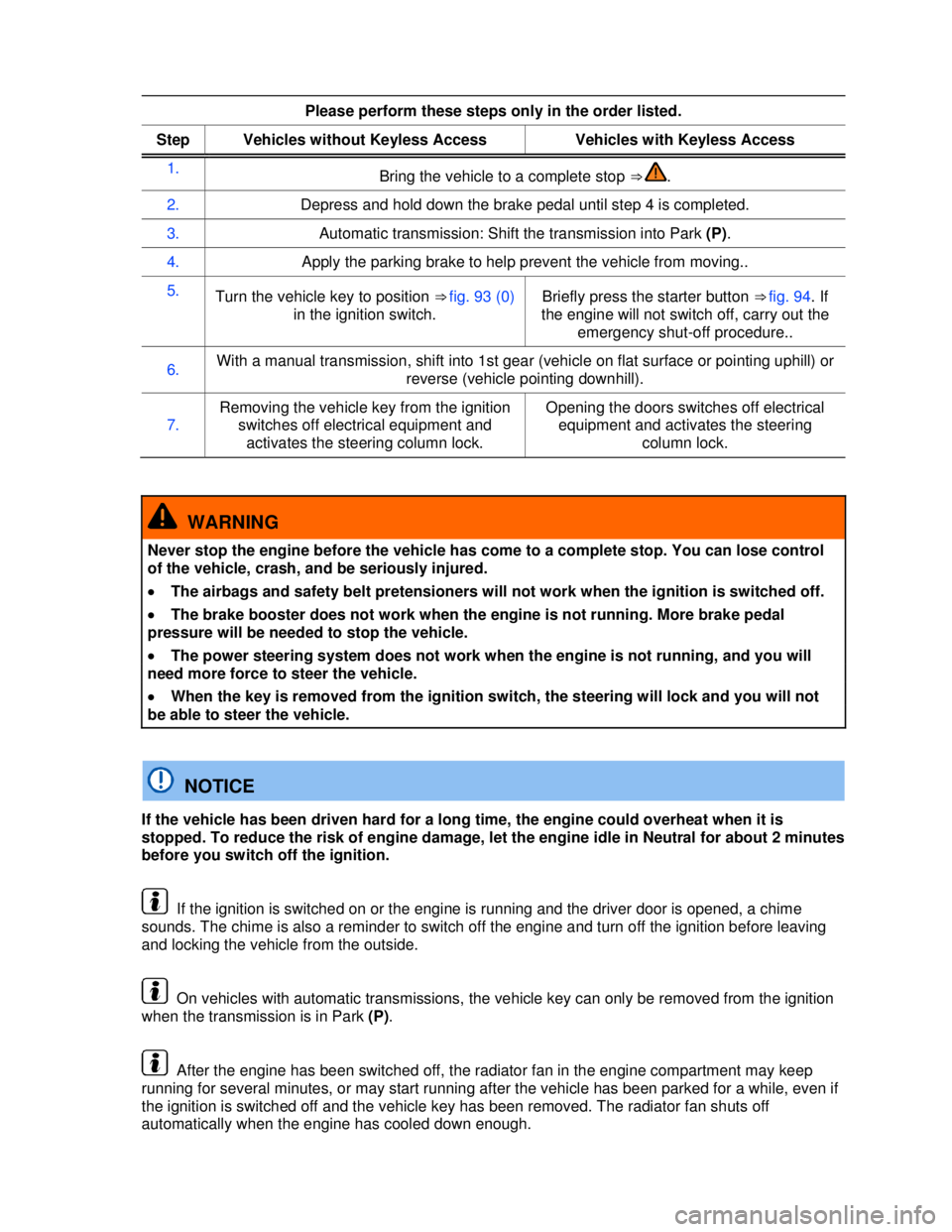
Please perform these steps only in the order listed.
Step Vehicles without Keyless AccessVehicles with Keyless Access
1. Bring the vehicle to a complete stop ⇒ .
2. Depress and hold down the brake pedal until step 4 is completed.
3. Automatic transmission: Shift the transmission into Park (P).
4. Apply the parking brake to help prevent the vehicle from moving..
5. Turn the vehicle key to position ⇒ fig. 93 (0)
in the ignition switch.
Briefly press the starter button ⇒ fig. 94. If
the engine will not switch off, carry out the
emergency shut-off procedure..
6. With a manual transmission, shift into 1st gear (vehicle on flat surface or pointing uphill) or
reverse (vehicle pointing downhill).
7.
Removing the vehicle key from the ignition
switches off electrical equipment and
activates the steering column lock.
Opening the doors switches off electrical
equipment and activates the steering
column lock.
WARNING
Never stop the engine before the vehicle has come to a complete stop. You can lose control
of the vehicle, crash, and be seriously injured.
�x The airbags and safety belt pretensioners will not work when the ignition is switched off.
�x The brake booster does not work when the engine is not running. More brake pedal
pressure will be needed to stop the vehicle.
�x The power steering system does not work when the engine is not running, and you will
need more force to steer the vehicle.
�x When the key is removed from the ignition switch, the steering will lock and you will not
be able to steer the vehicle.
NOTICE
If the vehicle has been driven hard for a long time, the engine could overheat when it is
stopped. To reduce the risk of engine damage, let the engine idle in Neutral for about 2 minutes
before you switch off the ignition.
If the ignition is switched on or the engine is running and the driver door is opened, a chime
sounds. The chime is also a reminder to switch off the engine and turn off the ignition before leaving
and locking the vehicle from the outside.
On vehicles with automatic transmissions, the vehicle key can only be removed from the ignition
when the transmission is in Park (P).
After the engine has been switched off, the radiator fan in the engine compartment may keep
running for several minutes, or may start running after the vehicle has been parked for a while, even if
the ignition is switched off and the vehicle key has been removed. The radiator fan shuts off
automatically when the engine has cooled down enough.
Page 124 of 268
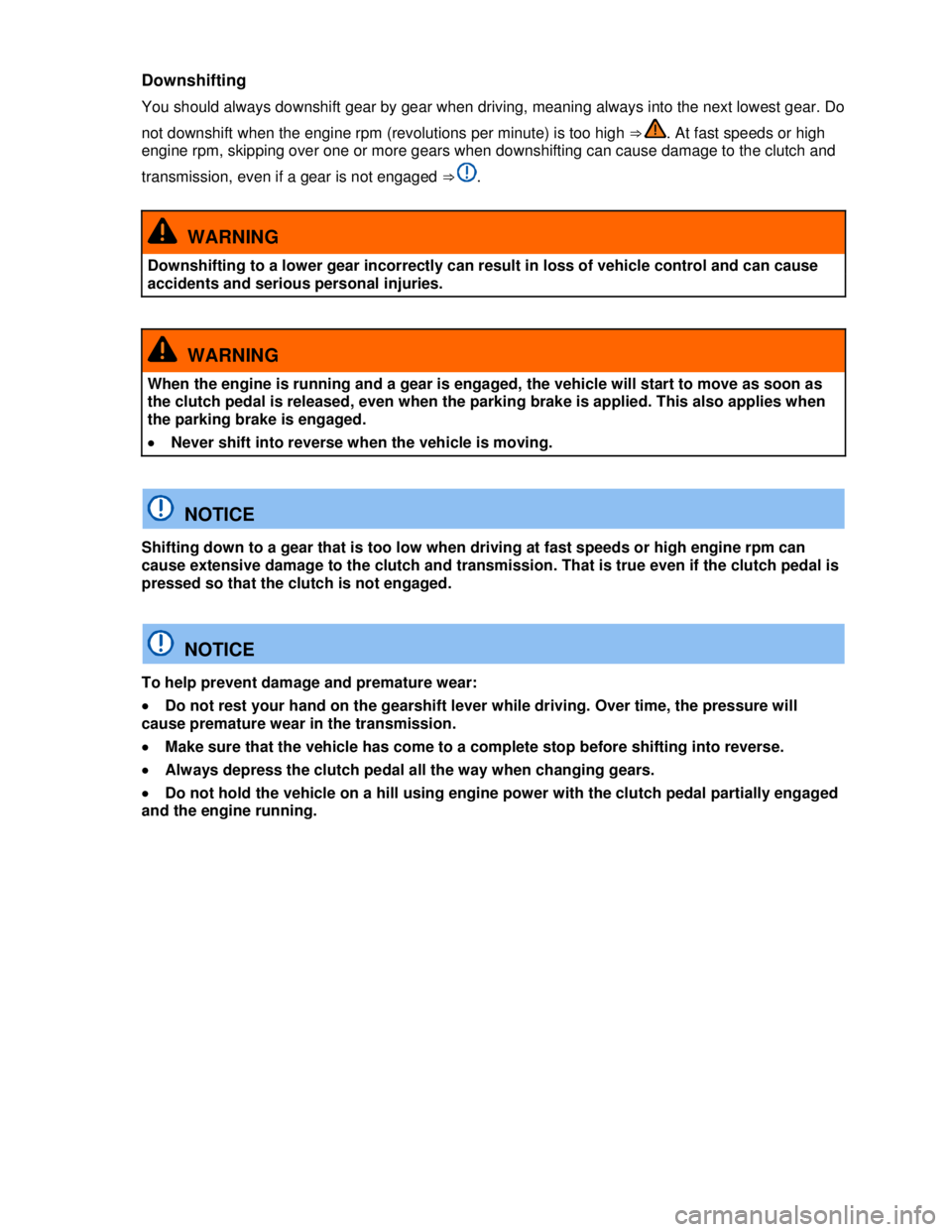
Downshifting
You should always downshift gear by gear when driving, meaning always into the next lowest gear. Do
not downshift when the engine rpm (revolutions per minute) is too high ⇒ . At fast speeds or high
engine rpm, skipping over one or more gears when downshifting can cause damage to the clutch and
transmission, even if a gear is not engaged ⇒ .
WARNING
Downshifting to a lower gear incorrectly can result in loss of vehicle control and can cause
accidents and serious personal injuries.
WARNING
When the engine is running and a gear is engaged, the vehicle will start to move as soon as
the clutch pedal is released, even when the parking brake is applied. This also applies when
the parking brake is engaged.
�x Never shift into reverse when the vehicle is moving.
NOTICE
Shifting down to a gear that is too low when driving at fast speeds or high engine rpm can
cause extensive damage to the clutch and transmission. That is true even if the clutch pedal is
pressed so that the clutch is not engaged.
NOTICE
To help prevent damage and premature wear:
�x Do not rest your hand on the gearshift lever while driving. Over time, the pressure will
cause premature wear in the transmission.
�x Make sure that the vehicle has come to a complete stop before shifting into reverse.
�x Always depress the clutch pedal all the way when changing gears.
�x Do not hold the vehicle on a hill using engine power with the clutch pedal partially engaged
and the engine running.
Page 126 of 268
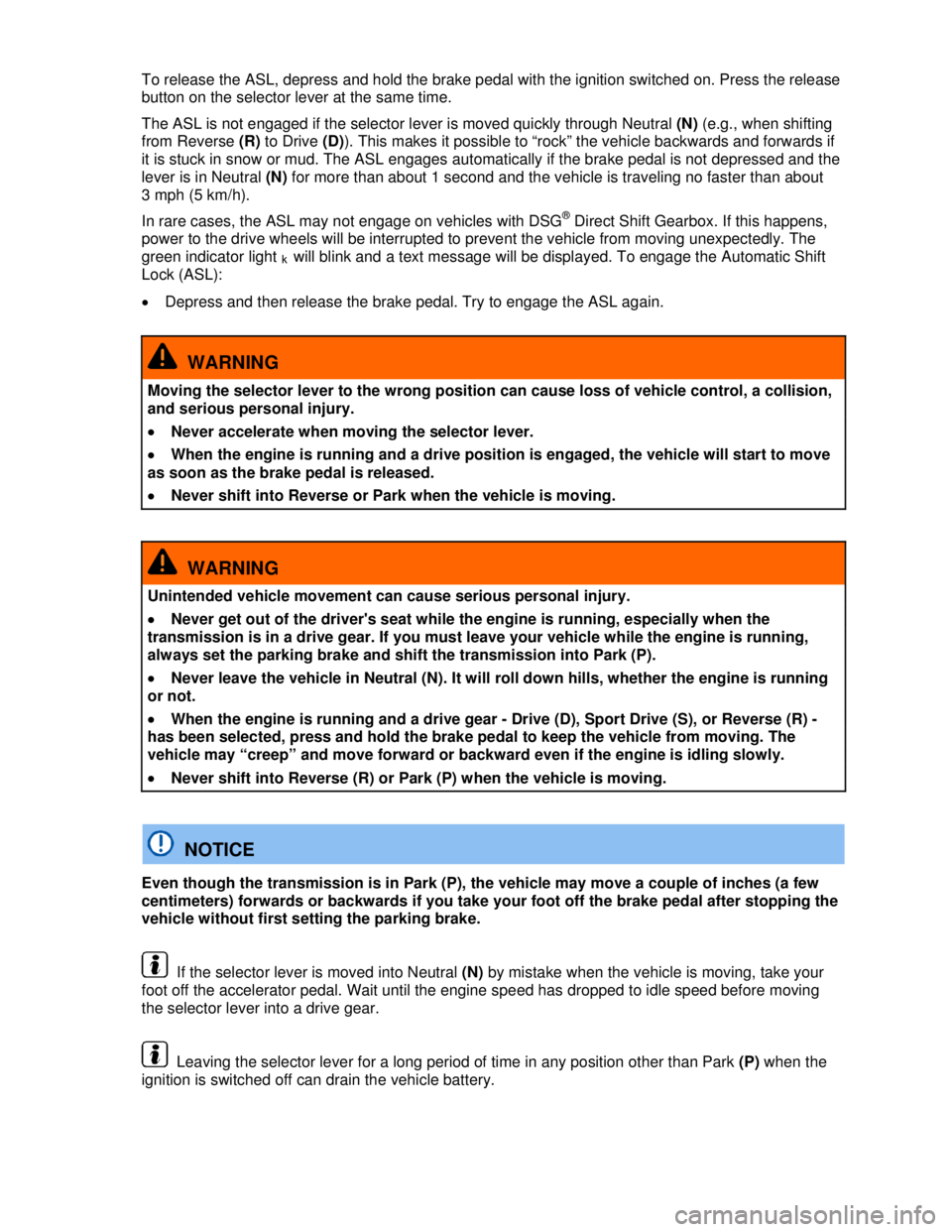
To release the ASL, depress and hold the brake pedal with the ignition switched on. Press the release
button on the selector lever at the same time.
The ASL is not engaged if the selector lever is moved quickly through Neutral (N) (e.g., when shifting
from Reverse (R) to Drive (D)). This makes it possible to “rock” the vehicle backwards and forwards if
it is stuck in snow or mud. The ASL engages automatically if the brake pedal is not depressed and the
lever is in Neutral (N) for more than about 1 second and the vehicle is traveling no faster than about
3 mph (5 km/h).
In rare cases, the ASL may not engage on vehicles with DSG® Direct Shift Gearbox. If this happens,
power to the drive wheels will be interrupted to prevent the vehicle from moving unexpectedly. The
green indicator light k will blink and a text message will be displayed. To engage the Automatic Shift
Lock (ASL):
�x Depress and then release the brake pedal. Try to engage the ASL again.
WARNING
Moving the selector lever to the wrong position can cause loss of vehicle control, a collision,
and serious personal injury.
�x Never accelerate when moving the selector lever.
�x When the engine is running and a drive position is engaged, the vehicle will start to move
as soon as the brake pedal is released.
�x Never shift into Reverse or Park when the vehicle is moving.
WARNING
Unintended vehicle movement can cause serious personal injury.
�x Never get out of the driver's seat while the engine is running, especially when the
transmission is in a drive gear. If you must leave your vehicle while the engine is running,
always set the parking brake and shift the transmission into Park (P).
�x Never leave the vehicle in Neutral (N). It will roll down hills, whether the engine is running
or not.
�x When the engine is running and a drive gear - Drive (D), Sport Drive (S), or Reverse (R) -
has been selected, press and hold the brake pedal to keep the vehicle from moving. The
vehicle may “creep” and move forward or backward even if the engine is idling slowly.
�x Never shift into Reverse (R) or Park (P) when the vehicle is moving.
NOTICE
Even though the transmission is in Park (P), the vehicle may move a couple of inches (a few
centimeters) forwards or backwards if you take your foot off the brake pedal after stopping the
vehicle without first setting the parking brake.
If the selector lever is moved into Neutral (N) by mistake when the vehicle is moving, take your
foot off the accelerator pedal. Wait until the engine speed has dropped to idle speed before moving
the selector lever into a drive gear.
Leaving the selector lever for a long period of time in any position other than Park (P) when the
ignition is switched off can drain the vehicle battery.
Page 132 of 268
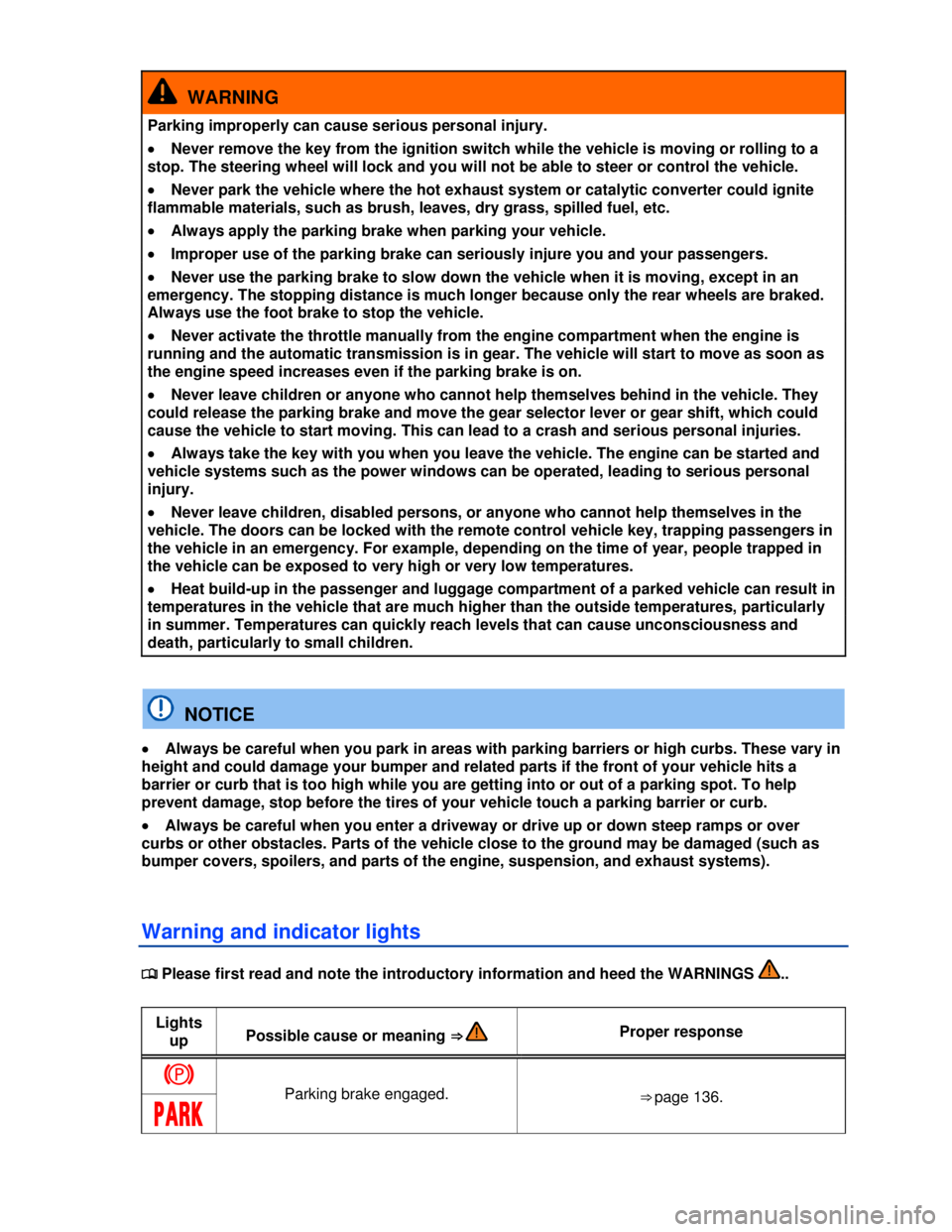
WARNING
Parking improperly can cause serious personal injury.
�x Never remove the key from the ignition switch while the vehicle is moving or rolling to a
stop. The steering wheel will lock and you will not be able to steer or control the vehicle.
�x Never park the vehicle where the hot exhaust system or catalytic converter could ignite
flammable materials, such as brush, leaves, dry grass, spilled fuel, etc.
�x Always apply the parking brake when parking your vehicle.
�x Improper use of the parking brake can seriously injure you and your passengers.
�x Never use the parking brake to slow down the vehicle when it is moving, except in an
emergency. The stopping distance is much longer because only the rear wheels are braked.
Always use the foot brake to stop the vehicle.
�x Never activate the throttle manually from the engine compartment when the engine is
running and the automatic transmission is in gear. The vehicle will start to move as soon as
the engine speed increases even if the parking brake is on.
�x Never leave children or anyone who cannot help themselves behind in the vehicle. They
could release the parking brake and move the gear selector lever or gear shift, which could
cause the vehicle to start moving. This can lead to a crash and serious personal injuries.
�x Always take the key with you when you leave the vehicle. The engine can be started and
vehicle systems such as the power windows can be operated, leading to serious personal
injury.
�x Never leave children, disabled persons, or anyone who cannot help themselves in the
vehicle. The doors can be locked with the remote control vehicle key, trapping passengers in
the vehicle in an emergency. For example, depending on the time of year, people trapped in
the vehicle can be exposed to very high or very low temperatures.
�x Heat build-up in the passenger and luggage compartment of a parked vehicle can result in
temperatures in the vehicle that are much higher than the outside temperatures, particularly
in summer. Temperatures can quickly reach levels that can cause unconsciousness and
death, particularly to small children.
NOTICE
�x Always be careful when you park in areas with parking barriers or high curbs. These vary in
height and could damage your bumper and related parts if the front of your vehicle hits a
barrier or curb that is too high while you are getting into or out of a parking spot. To help
prevent damage, stop before the tires of your vehicle touch a parking barrier or curb.
�x Always be careful when you enter a driveway or drive up or down steep ramps or over
curbs or other obstacles. Parts of the vehicle close to the ground may be damaged (such as
bumper covers, spoilers, and parts of the engine, suspension, and exhaust systems).
Warning and indicator lights
�
Page 134 of 268
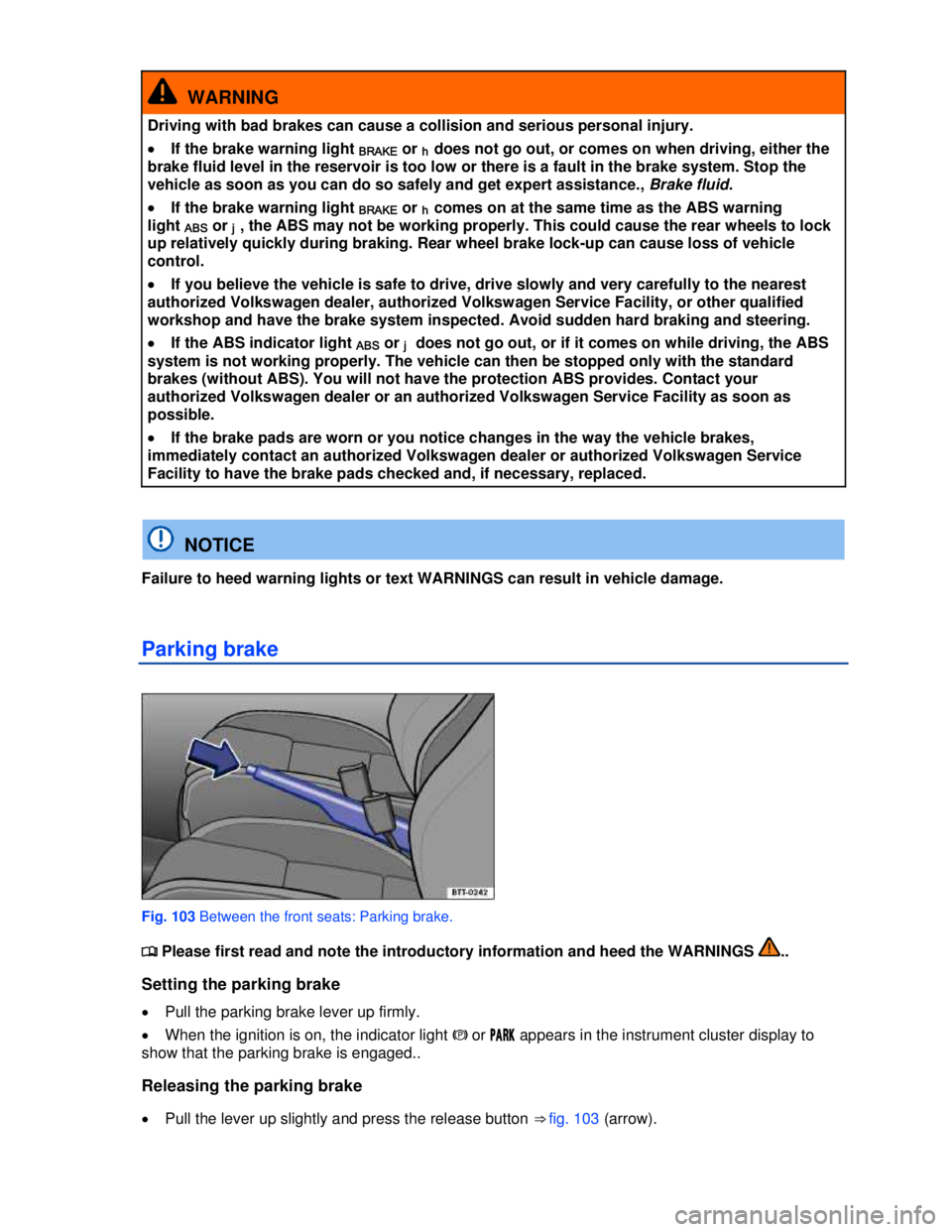
WARNING
Driving with bad brakes can cause a collision and serious personal injury.
�x If the brake warning light BRAKE or h does not go out, or comes on when driving, either the
brake fluid level in the reservoir is too low or there is a fault in the brake system. Stop the
vehicle as soon as you can do so safely and get expert assistance., Brake fluid.
�x If the brake warning light BRAKE or h comes on at the same time as the ABS warning
light ABS or j, the ABS may not be working properly. This could cause the rear wheels to lock
up relatively quickly during braking. Rear wheel brake lock-up can cause loss of vehicle
control.
�x If you believe the vehicle is safe to drive, drive slowly and very carefully to the nearest
authorized Volkswagen dealer, authorized Volkswagen Service Facility, or other qualified
workshop and have the brake system inspected. Avoid sudden hard braking and steering.
�x If the ABS indicator light ABS or j does not go out, or if it comes on while driving, the ABS
system is not working properly. The vehicle can then be stopped only with the standard
brakes (without ABS). You will not have the protection ABS provides. Contact your
authorized Volkswagen dealer or an authorized Volkswagen Service Facility as soon as
possible.
�x If the brake pads are worn or you notice changes in the way the vehicle brakes,
immediately contact an authorized Volkswagen dealer or authorized Volkswagen Service
Facility to have the brake pads checked and, if necessary, replaced.
NOTICE
Failure to heed warning lights or text WARNINGS can result in vehicle damage.
Parking brake
Fig. 103 Between the front seats: Parking brake.
�
Page 135 of 268
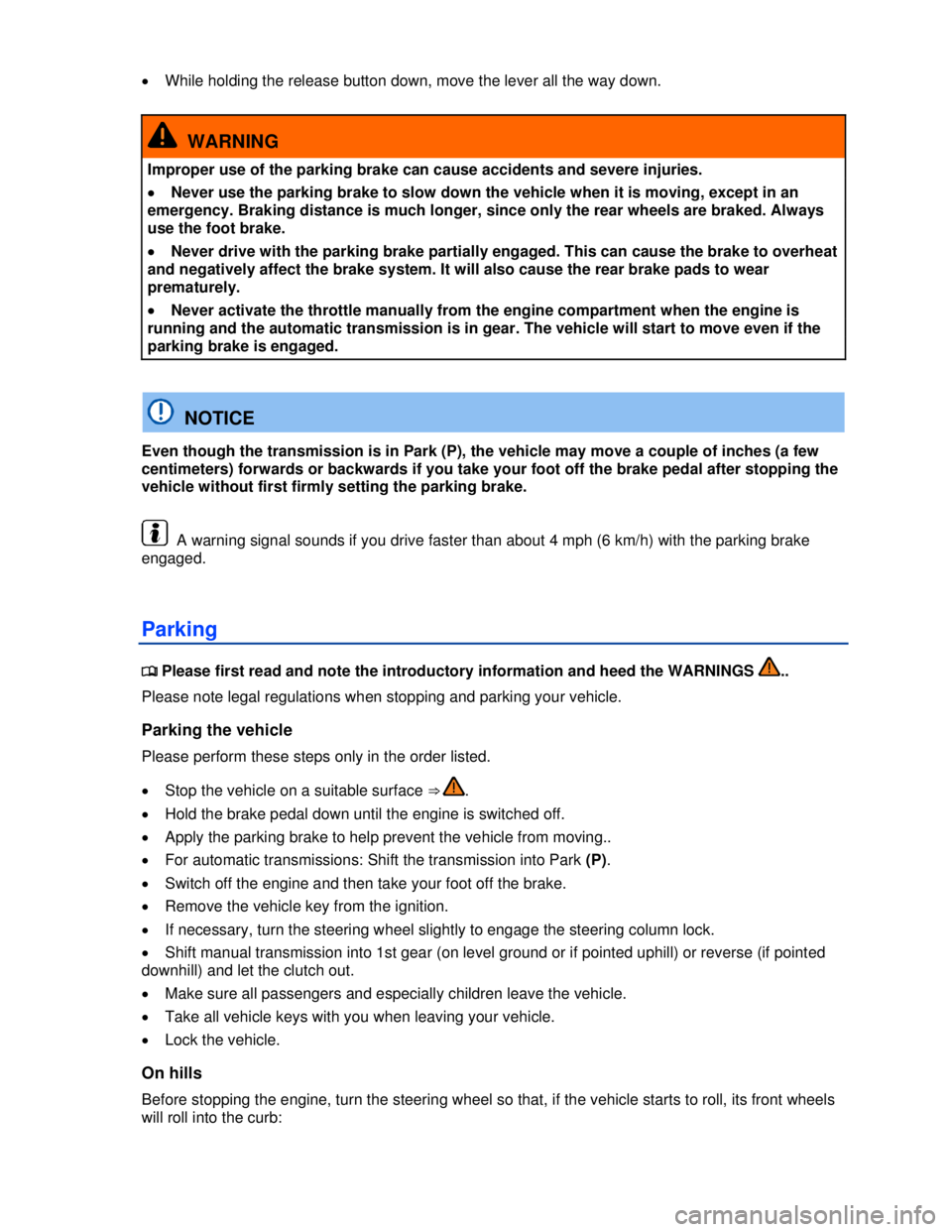
�x While holding the release button down, move the lever all the way down.
WARNING
Improper use of the parking brake can cause accidents and severe injuries.
�x Never use the parking brake to slow down the vehicle when it is moving, except in an
emergency. Braking distance is much longer, since only the rear wheels are braked. Always
use the foot brake.
�x Never drive with the parking brake partially engaged. This can cause the brake to overheat
and negatively affect the brake system. It will also cause the rear brake pads to wear
prematurely.
�x Never activate the throttle manually from the engine compartment when the engine is
running and the automatic transmission is in gear. The vehicle will start to move even if the
parking brake is engaged.
NOTICE
Even though the transmission is in Park (P), the vehicle may move a couple of inches (a few
centimeters) forwards or backwards if you take your foot off the brake pedal after stopping the
vehicle without first firmly setting the parking brake.
A warning signal sounds if you drive faster than about 4 mph (6 km/h) with the parking brake
engaged.
Parking
�